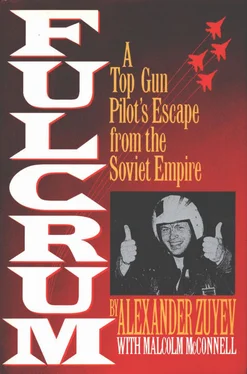During the five historic days of the failed coup d’etat in Moscow that August, I was pleased to learn that other military men had apparently taken my words to heart as well. I was able to broadcast a message on Radio Liberty, appealing directly to the Soviet officers and soldiers in the BMPs and armored cars on the streets of Moscow. I reminded them of the Tbilisi massacre and asked them to consider to whom they owed true loyalty, the Party bosses or the people. Perhaps these words made some difference. In any event, Soviet soldiers refused to obey orders to fire on civilians, or to storm the Russian Parliament to arrest Boris Yeltsin.
And I was also able to influence my former colleagues in another unexpected way. The tape-recorded message I had left behind in my apartment at Tskhakaya had never been seized by the KGB. Instead, pilots from my regiment had found the tape before the Osobists. My friends had apparently passed the tape unofficially among their colleagues. One officer that I knew for certain had heard my message was Lieutenant General of Aviation Yevgeni Ivanovich Shaposhnikov, the deputy chief of staff of the Air Force, who led the official investigation into the hijacking. Shaposhnikov was a real reformer, a patriotic professional officer who knew where his true loyalties lay. After the failed coup, when Yazov and his Communist proteges in the Defense Ministry were disgraced, General Shaposhnikov became the new Defense Minister.
“Sasha,” my brother, Misha, said, tugging my sleeve. “Look.” The red hammer-and-sickle banner was sliding down the flagpole above the Kremlin ramparts. Mother came from the kitchen. Valentin stood up beside the Christmas tree. We watched in silence. Then the blue, red, and white banner of the Russian Republic rose in the Moscow wind.
“Is it really over?” Mother asked. “Has it ended?"
“Yes,” I answered, stretching my arms around my family. “It has finally ended.” I stared at the ancient flag of Russia. Where would all this really end? I spoke again. “It is over. But there is still so far to go.”
Afghansti: A Soviet military veteran of the Afghanistan war.
afterburner: A thrust augmentation system for jet engines, which sprays fuel to be ignited in the exhaust pipe.
air brake: A movable flap to induce drag and decelerate an aircraft.
AK-47: Avtomat-Kalashnikova: A Soviet 7.62 mm assault rifle designed by Kalashnikov.
Akhtubinsk: One of the key Soviet air-test centers, located in the southern Russian Republic.
AKM: A modernized version of the AK-47 assault rifle.
Alamo missile: The Soviet R-27 radar-controlled Air-to-Air missile.
An-12: A four-engine Antonov military transport, similar to the U.S. C-130.
An-2 ( Anushka ): A slow, sturdy, single-engine Soviet biplane transport, often used to drop paratroops.
angle of attack (AOA): The angular distance of an aircraft’s lifting surfaces (wings, etc.) above the horizontal.
apparat: Soviet government bureaucracy. apparatohik: Soviet government bureaucrat.
Archer missile: The Soviet R-73 infrared-homing Air-to-air missile.
avos’ka: A string or plastic shopping bag; the ubiquitous symbol of the failed Soviet economy.
AWACS: U.S. Airborne Warning and Control System aircraft, which directs modern air battles.
babushka: Russian, grandmother.
bantia: Russian, criminal gang.
Black Raven: The black van used by Stalin’s secret police to transport people under arrest.
blat: Russian, “clout” or influence.
BMP: A Soviet-designed, tracked armored personnel carrier.
CAP: U.S. military acronym, Combat Air Patrol.
chaff: Radar-blocking system employing clouds of thin aluminum strips, ejected in packets from a military aircraft. Crocodile (MiG-23): Soviet pilots’ slang for the MiG-23 fighter.
dacha: Russian, “cottage,” size depends on status.
DShK: A Soviet-designed 12.7mm machine gun, often used in air defense.
Dushman: Russian, “bandit,” a derogatory term for the anti-Soviet Afghan resistance.
Frontal Aviation Regiments: The fighter and fighter-bomber units of the Soviet Air Force.
full military power: Maximum throttle setting short of afterburner, equal to 100 percent of normal engine power.
G-force: The acceleration forces acting on an aircraft; “G” can be expressed as positive or negative, with 1 G being the aircraft’s normal resting weight.
G-indicator: An instrument to measure the acceleration forces on an aircraft.
G-suit: A protective garment worn by military pilots, which employs inflatable bladders to constrict the body and reduce blood flow away from the brain during high-performance maneuvers.
GAZ: The generic term for many Soviet-design military vehicles, ranging from “jeeps” to heavy trucks.
GCI: Ground Control Intercept: the air traffic control of military aircraft by ground-based radar operators.
gorka: Russian, climb (aerial maneuver).
Gosplan: The Soviet Central Planning Ministry.
GSh-301: The 30 mm automatic cannon on the MiG-29 Fulcrum.
Guards: An honorific title applied to certain Soviet military units, which have earned that distinction in battle. GULag: Soviet acronym, Central Administration for Corrective Labor Camps; made infamous by Russian writer Alexander Solzhenitsyn, who coined the term, “gulag archipelago.”
HMS: Soviet Helmet Mounted Sight.
HUD: Head Up Display: an optical cockpit display, which projects crucial data on a transparent screen, which does not restrict the pilot’s view forward.
Il-2: The Ilyushin “Shturmovik” fighter-bomber of World War II fame.
Il-76: An Ilyushin Design Bureau four-engine military jet transport similar to the U.S. C-141.
ILS: Instrument Landing System.
IRST: Infrared Search and Track (targeting system).
K-36D: A modern Soviet-design fighter aircraft ejection seat.
Kalashnikov: The designer of the AK-47.
KGB: Soviet Committee for State Security, the secret police.
kolkhoz: Russian, collective farm.
kollectiv: Russian, the Communist and “worker” members of any Soviet organization.
Kolyma: An infamous Soviet mining labor camp in the Far East of Siberia.
Komsomol: The Soviet Young Communist Party Organization.
krug: Russian, a horizontal, circular aerial maneuver.
kursant: Russian, a military cadet.
L-29: A Czech-design single-engine jet trainer.
LA-17: A rocket-powered aerial target drone.
laser range finder: A measuring device using laser light to calculate distance.
Lenin Room: A part of a Soviet military barracks reserved for troops’ reading and propaganda.
look-down, shoot-down radar: A pulse-Doppler fighter radar system that can track low-flying enemy targets normally masked by the ground below.
Mach: The speed of sound at any given atmospheric altitude and temperture.
Makarov: Designer of the standard Soviet semi-automatic 9mm handgun; the gun itself.
malchi-malchi; “Hush-hush"; often applied to nuclear weapons procedures in the Soviet military.
Mi-8: A Mikoyan Design Bureau troop-carrying helicopter; forerunner of the Mi-24 troop carrier assault gunship.
microrayon: Russian, a State-planned housing project, often in isolated suburban areas.
MiG: Soviet acronym for Mikoyan and Gureyvich Design Bureau, the most successful Soviet military aircraft builder, known in later years simply as the “Mikoyan Design Bureau.”
MiG-21FM; The two-seat trainer version of the Mikoyan Design Bureau MiG-21.
MiG-23UB: The two-seat trainer version of the Mikoyan Design Bureau MiG-23.
MiG-29: The Mikoyan OKB’s first “fourth generation” fighter, equal in performance to U.S. F-16 and F/A-18 aircraft; NATO designation, Fulcrum.
Читать дальше










